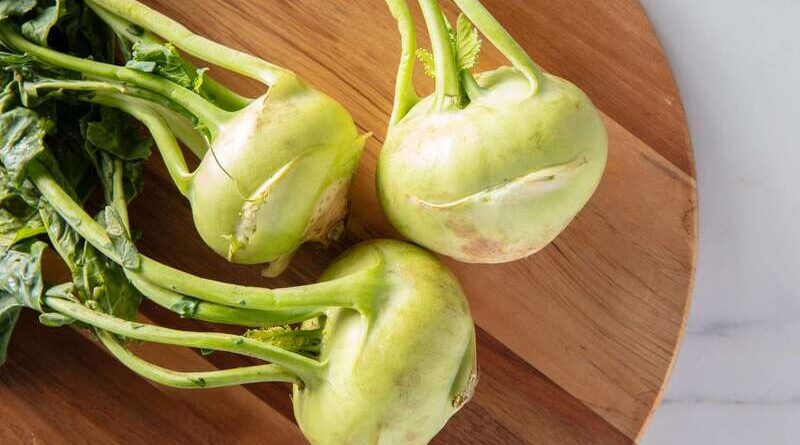Unlocking the Delicious Secrets of Kohlrabi: A Culinary Journey
Greetings from the amazing world of kohlrabi! This unusual vegetable has a long history and many nutritional advantages, but it is sometimes disregarded in popular cooking. This article tries to unlock the mysteries of kohlrabi, from its history to its culinary adaptability, and it invites you to discover its many flavors and possible health benefits. Whether you’re an experienced gardener or just an inquisitive foodie, come along on this adventure to learn about the benefits of it.
History and Origin
A member of the Brassica family, it is originated in Europe during the sixteenth century. The names “cabbage” and “turnip” which are derived from German, give away some information about its appearance and flavor. It was first grown in the Mediterranean area and then progressively expanded throughout Europe and beyond.
It gained popularity over time as a mainstay in many different cuisines due to its versatility and high nutritional content. The path of it from its modest beginnings to its widespread recognition today demonstrates its continuing appeal and relevance in culinary traditions around the world.
Varieties of Kohlrabi
Kohlrabi is a versatile vegetable that offers a multitude of culinary possibilities and visual appeal due to its diverse forms, sizes, and colors. Although all kohlrabi cultivars are members of the same species, Brassica oleracea. They differ in certain ways that allow them to be used in different ways for cooking and growing environments.
Green Kohlrabi:
- The most popular type of kohlrabi is green, which is distinguished by its light green or pale green skin.
- This cultivar works well in both raw and cooked recipes because of its mild, sweet flavor and crisp, juicy texture.
- Although larger bulbs can be collected and used as well. Green kohlrabi is typically harvested when the bulb reaches a diameter of two to three inches.
Purple Kohlrabi:
- The vivid purple or reddish-purple skin of purple kohlrabi gives dishes a burst of color.
- Although purple kohlrabi tastes identical to green kohlrabi, some people prefer a little more spice.
- Similar to green kohlrabi, purple kohlrabi can be cooked in a variety of ways or eaten raw in salads or salads.
White Kohlrabi:
- The skin of white kohlrabi sometimes referred to as “White Vienna” is creamy or pale white in hue.
- When compared to purple and green kohlrabi, this type usually tastes a little sweeter and softer.
- White kohlrabi is a popular choice for raw eating or light cooking techniques like roasting or steaming because of its delicate texture and mild flavor.
Giant Kohlrabi:
- Larger bulbs are produced by giant kohlrabi types, which can occasionally resemble little melons.
- In comparison to smaller types, these may take longer to develop and need plenty of area to thrive.
- Giant kohlrabi are less frequent than standard-sized kinds, but they yield a lot more and can be utilized in a variety of culinary applications, such as pickling and fermenting in addition to soups and stews.
Hybrid Varieties:
- Hybrid cultivars have been created in addition to traditional kohlrabi varieties to improve particular qualities like flavor, yield, or disease resistance.
- Unique traits like uniform size, increased color intensity, or faster development are possible in hybrid kohlrabi.
- A wide range of hybrid kohlrabi types are available for gardeners and farmers to choose from, depending on their growing conditions and preferences.
Nutritional Value and Health Benefits
Full of vital vitamins, minerals, and antioxidants, it is a nutritional powerhouse. With just one serving, it provides a substantial amount of the daily required consumption of vitamin C due to its high vitamin content. It also contains manganese, potassium, and vitamin B6, all of which are beneficial for bone health, neuron function, and a healthy metabolism.
Kohlrabi’s high dietary fiber content supports healthy digestion and aids in blood sugar regulation. Its anti-oxidant qualities lower the risk of chronic illnesses including cancer and heart disease by battling oxidative stress and inflammation. Including it in your diet can improve your general health and energy level.
Growing and Cultivation Techniques
Cool climes and well-draining soil with a pH of 6.0 to 7.5 are ideal for it growth. Sow seeds directly in the garden or indoors four to six weeks before the last frost. Arrange plants in rows 12–18 inches apart.
Maintain regular moisture in the soil without becoming soggy. Fertilize four times a week. When the bulbs are 2-3 inches in diameter, harvest them. It takes 45–60 days to develop.
Culinary Uses and Recipes
The culinary uses of it are likewise varied, providing a plethora of delectable recipes to try. For a cool crunch, eat it raw in salads or salads. Alternatively, roast it with herbs and olive oil to make a flavorful side dish.
Make kohlrabi fritters or combine them into a creamy soup for a fresh take. Chefs and family cooks alike love it because of its mild, sweet flavor and crisp texture, which allow it to be used in a wide range of culinary endeavors.
Conclusion
In summary, kohlrabi offers a fascinating adventure for gardeners and food fans alike, with its rich history, numerous cultivars, and plenty of nutritional benefits. It is a great addition to any kitchen due to its flexibility and culinary variety, which have helped it rise from humble beginnings in Europe to its current global reputation.
Kohlrabi’s mild flavor and crisp texture make it a great culinary experience that may be added to salads, roasted and eaten as a side dish, or creatively incorporated into recipes. It also enhances overall well-being. Accept the miracles of it and let its distinct characteristics spark your interest in cooking.
